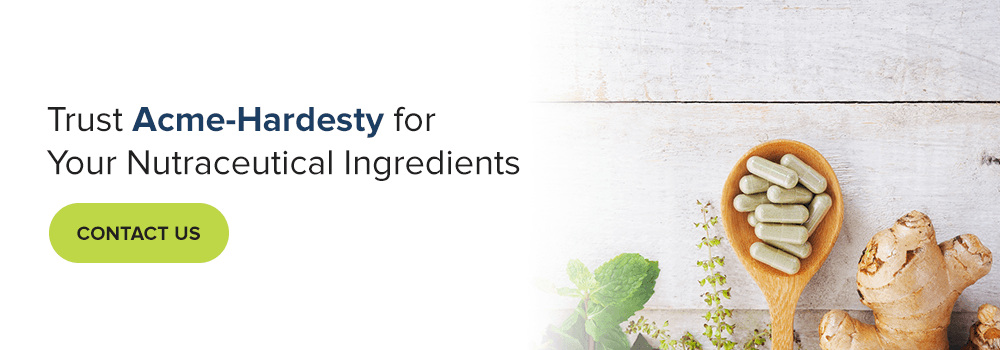Your Guide to Nutraceuticals
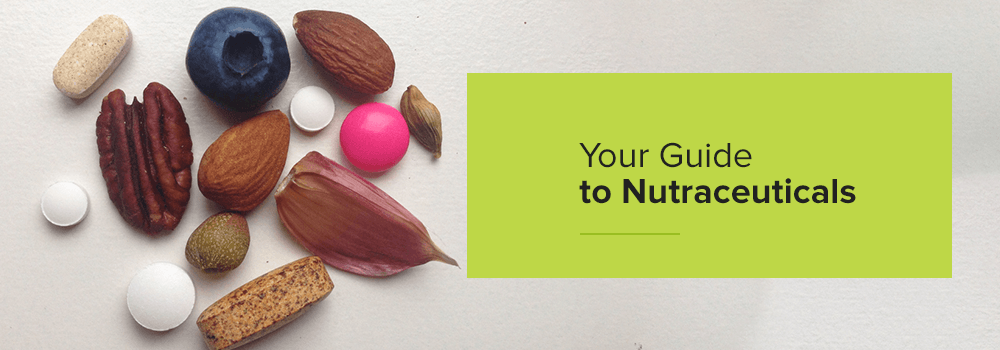
Jump to:
“Nutraceutical” is the combination of two words –– “nutrient” and “pharmaceutical.” A nutrient is a nourishing component found in food and a pharmaceutical is a medical drug. Nutraceuticals are used for prevention, as nutrition can have a significant impact on a person’s health.
Nutraceuticals represent an exciting opportunity in the improvement of health. Manufacturing industries understand the possibilities of this opportunity to supply quality ingredients, and we hope to see the use of nutraceuticals recommended widely.
In this guide, we detail what nutraceuticals are used for, the difference between pharmaceuticals, nutraceuticals and functional food, the health benefits of nutraceuticals and current trends in the nutraceutical industry.
As with any health guides, it is recommended for individuals to always consult with their health care provider before starting any diet, supplement or exercise programs.
What Are Nutraceuticals?
The term “nutraceutical” dates back to 1989, when physician Stephen DeFelice, founder and chairman of the Foundation for Innovation in Medicine, coined the term to describe products derived from food sources that offer extra health benefits along with the basic nutritional value of foods.
So what exactly are nutraceutical supplements? In short, for a product to be considered a nutraceutical, it must:
- Be derived from a food source
- Offer additional health benefits beyond general, basic nutrition
The medical and health industry of today has embraced the term as the inspiration for several products and options for treating illnesses. Nutraceuticals have become a billion-dollar industry in the U.S., Europe and Japan. So what has everyone so interested in this product?
Nutraceuticals can control symptoms, may reduce the risk of chronic disease, may aid in the treatment of disease and promote general well-being. Many nutraceuticals are widely recognized for joint and spine problems, such as chondroitin sulfate, fish oils, glucosamine sulfate and an herb known as Boswellia.
A nutraceutical product may offer a single nutrient or multiple ingredients together. They may also come in the form of herbal products or be genetically engineered as designer food. Processed foods with added nutrients can also contain nutraceuticals.
Examples of Nutraceuticals
Nutraceuticals include:
- Carotenoids, such as lycopene
- Dietary enzymes, such as papain and bromelain
- Hydrolyzed proteins
- Mineral supplements
- Phytonutrients, such as resveratrol
- Prebiotic and probiotic supplements
- Dietary fiber supplements
- Vitamin supplements
- Herbal products, such as:
- Echinacea
- Ginger
- Garlic
- Ginseng
- Onion
- Licorice root
- Turmeric
Many consumers may already have these products in their homes without even realizing they are nutraceuticals.
While dietary supplements are used to supplement a diet, nutraceuticals go beyond supplementing to reduce the risk of disease and aid treatment. With the increasing interest in preventive healthcare in the western world, it’s no wonder this industry is growing so rapidly.
How Do Nutraceuticals Work?

Nutraceuticals may provide consumers with added nutrition. If a consumer’s diet isn’t supplying them with all the nutrients and vitamins their body needs, then nutraceuticals can help. Nutraceuticals can be especially important if a consumer is managing an injury or illness or if they are putting extra physical strain on their body, as these situations can increase the number of nutrients our bodies need.
Metabolism is a process that breaks down the nutrients in our food to produce energy. Nutrients like proteins, carbohydrates and fats provide energy, while nutrients like vitamins, electrolytes, minerals and water help our bodies maintain healthy metabolisms. Having enough nutrients allows the organs and systems in our bodies to function properly and may aid in healing wounds or injuries thoroughly and quickly. Not having the right amount of nutrients can mean our bodies will take longer to heal or injuries may even worsen.
A healthy diet is one of the best ways to ensure we maintain good health and should contain all the nutrients our bodies need to keep functioning well. If your diet isn’t providing enough nutrients for your body, then consider supplementing with nutraceuticals.
Nearly half of Americans take at least one prescription drug, and many grow tired of relying on pharmaceuticals or long to incorporate a more holistic approach when it comes to their health. That’s where nutraceuticals come in.
Difference Between Nutraceuticals and Pharmaceuticals
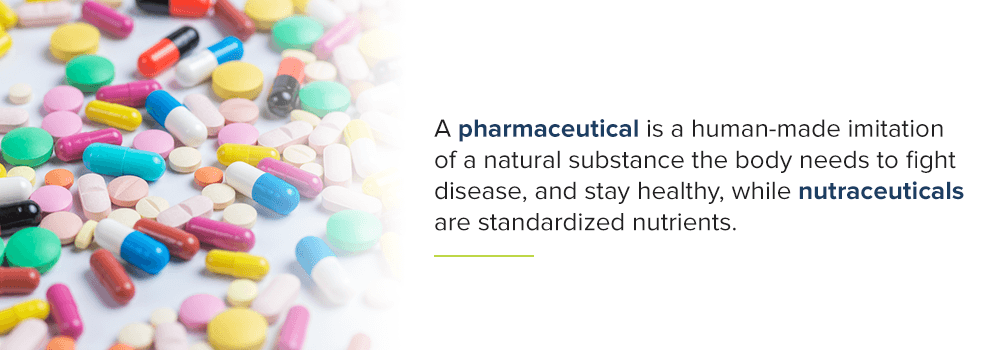
What is the difference between a nutraceutical and a pharmaceutical? A pharmaceutical is a human-made imitation of a natural substance the body needs to fight disease, stay healthy and provide the body with needed ingredients, while nutraceuticals are standardized nutrients.
While the two product types may work together, there are significant differences between them.
1. Regulation
The EU has been introducing legislation over the past few years that will replace many national laws with the intent of harmonizing natural health legislation. Regulations are made with the goal of:
- Effectively protecting consumers
- Enabling the free movement of goods in the EU
Regulation is a major difference between nutraceuticals and pharmaceuticals. While you almost always need a prescription from a healthcare provider to obtain pharmaceuticals, you don’t typically need a prescription for nutraceuticals.
For many pharmaceuticals, consumers must follow their medical doctor’s guidance in regards to usage. In contrast, most nutraceuticals don’t require medical supervision, however, it is always recommended to consult a physician for specifics on individual contraindications when adding or ending any nutraceutical or pharmaceutical.
Nutraceuticals aren’t regulated or clinically proven and extensively studied like pharmaceuticals. With nutraceuticals, people can be proactive with their health and address health issues in attempts to reduce risk factors.
Because nutraceuticals are not regulated by the FDA final package labeling suggesting any health claims must include the following messaging contained within a black box: “This statement has not been evaluated by the Food and Drug Administration. This product is not intended to diagnose, treat, cure, or prevent any disease.” There is frequently a generally accepted expectation of a nutraceutical within scientific evidence supporting a claim as persuasive but not conclusive.
2. Nutraceutical Ingredients
Pharmaceutical products are approved by the FDA after rigorous clinical trials proving efficacy in a specific area of treatment. Pharmaceutical medications can either cure a disease, as an antibiotic cures strep throat or prevent a disease, as hypertension medications control blood pressure which can reduce the risk of stroke and heart attacks.
“Side effect” doesn’t necessarily mean a “negative effect.” Pharmaceuticals can actually become marketable because of its side effects. Viagra was famously originally developed to treat hypertension and angina. The strength of the pharmaceutical industry is in its ability to find drugs that we haven’t found in nature, helping us fight diseases when we haven’t discovered a natural cure.
Nutraceuticals are naturally-occurring compounds. Thus, nutraceuticals could be an option for many consumers who are skeptical of pharmaceuticals or who experience reactions to pharmaceuticals.
3. Limitations on Research and Marketing
Nutraceuticals can be more affordable, however not covered by insurance plans, than pharmaceuticals, and therefore, they are more accessible to consumers. Nutraceuticals also don’t require prescriptions, making them more widely available to the public.
Where pharmaceuticals shine is in marketing because pharmaceuticals are backed by scientific research that can support the claim they make about improving health. Pharmaceuticals have FDA regulated limitations on marketing and require claim adherence and ‘fair balance’ of listing any side effects experienced by the clinically-studied patient population.
The United States Food and Drug Administration (FDA) sets limits on what can and cannot appear on nutraceuticals, such as the requirement for a disclaimer indicating the product isn’t medication. Under the FDA’s rules, nutraceuticals can’t claim to be a treatment, medication or cure for a certain disease, whereas a pharmaceutical could make these claims and justify them with backing from medical research.
Still, even with these limitations on marketing, nutraceuticals hold the important advantages over pharmaceuticals of being more affordable and accessible without prescriptions.
4. Consumer Perception
Consumers perceive nutraceuticals and pharmaceuticals in two distinctly different ways –– nutraceuticals are viewed as prevention, while pharmaceuticals are viewed as treatment.
When consumers use nutraceuticals and pharmaceuticals together, they may be able to sustain or restore their health and recover faster. If consumers are focused on preventing disease, increasing their intake of nutrients or recovering after an injury illness, a nutraceutical is an optional product to purchase.
Difference Between Functional Food and Nutraceuticals

For many consumers, distinguishing between nutraceuticals and functional foods can be difficult. Sometimes the line between drugs and food can be blurred, and the definitions of supplements, functional foods and nutraceuticals can overlap. Despite their similarities, however, each product has its own place in the food industry.
The FDA regulates these products under the Federal Food Drug and Cosmetic Act, though these foods aren’t specifically defined by law. Fortunately for manufacturers, they typically don’t need to get their products FDA-approved or register products with the FDA before they can produce and sell them, though of course they do need to make sure the information on their product labels are not misleading.
So what are the differences between nutraceuticals and functional food?
Nutraceuticals can be whole food rather than an isolated vitamin or nutrient. This whole food is repackaged and concentrated in a non-food format, such as a capsule. Examples of nutraceutical foods include beets, spinach and garlic capsules. When consumed, these whole, concentrated products can aid in the prevention of disease and promote health.
Functional foods include fortified, enhanced or enriched foods and whole foods that have the potential to benefit one’s health when they are consumed regularly at an effective level as a part of a varied diet. These functional foods are enriched to benefit a consumer’s overall nutrition.
Functional foods today tend to come in the form of snacks, drinks, cereals, pasta, powders, bars and more. Think rice cereal that includes minerals and vitamins, apples for pie-filling or snacks, gluten-free bread for consumers who have dietary restrictions, energy drinks, baby formula and probiotic yogurt.
In short, functional foods versus nutraceuticals can be broken down as:
- Functional foods: Food products that have been modified for additional nutrition.
- Nutraceuticals: Products made from only whole foods to improve or preserve health.
While related, nutraceuticals and functional foods are distinct products in the industry. Considering that preventive healthcare and improving health is a growing concern for many Americans, this area of the market is likely to grow quickly.
Benefits of Nutraceuticals
Are nutraceuticals effective? More and more consumers in the U.S. are taking food supplements, and doctors are flocking to this field, which says enough about the perceived effectiveness of nutraceuticals. Some doctors are even prescribing nutraceuticals in lieu of pharmaceuticals, as they can help patients prevent diseases and achieve optimal levels of health.
1. Improve Health
You are what you eat, and consumers are quickly catching on to the importance of preventive health, and thus, the importance of nutraceuticals. Health benefits of nutraceuticals include an increase in wellbeing and overall health of individuals and the improvement of our ability to cope with stress.
These products can complement and boost a healthy diet so that consumers can take control of their health.
As Hippocrates said, “Let food be thy medicine.”
2. May Reduce Risk of Chronic Diseases
While prescription medication can be an effective treatment option, nutraceuticals can be part of powerful prevention options.
Rather than battle diseases after onset, consumers can take steps to prevent diseases and infections from manifesting in the first place or stopping the disease before it becomes a serious health problem. Diseases that nutraceuticals may assist or aid in treating include:
- Gastrointestinal disorders
- Renal disorders
- Diabetes
- Heart disease
- Obesity
- Parkinson’s disease
- Alzheimer’s disease
- Cancer
- Autoimmune conditions
- Infections
- Allergies
- Visual disorders
With the use of nutraceuticals as part of an overall healthy lifestyle, treating these diseases, illnesses and conditions can be much more manageable or even entirely preventable.
3. Increase Life Expectancy
Nutraceuticals are preventive care, and preventive care has been shown to increase life expectancy significantly. Catching diseases before they’re a major problem or before they start to affect the patient helps treatment and recovery occur quickly. Even better, treatment may not be necessary at all.
Nutraceuticals have also been shown to postpone the aging process, which in turn can increase your life expectancy.
4. Support Your Body’s Functions and Integrity
Nutraceuticals can also play a significant role in the body’s immune status and biological processes. These include:
- Protection of mitochondrial integrity
- Antioxidant defense
- Gene expression
- Cell proliferation
By playing a role in these biological processes, nutraceuticals can help our bodies thrive and prevent disease.
The use of nutraceuticals can play a significant role in our body’s overall health, which naturally lends itself to improving our mental wellbeing as well. Poor health can have a significantly negative impact on our happiness and overall mental wellbeing. Fortunately, nutraceuticals allow consumers to take control of their health and their happiness.
Trends in the Nutraceutical Industry
In recent years, the nutraceutical industry has been rapidly growing in popularity. A few major trends could affect the industry, even trends that may seem to have little to do with nutraceuticals on the surface.
Manufacturers in the nutraceutical industry should be aware of these trends so they can anticipate any upcoming changes.
1. Cosmetics

Nutraceuticals are growing more popular as anti-aging products. Consumers like the idea of taking a pill every morning to avoid wrinkles, gray hair and age spots. Millennials are an ideal market for these products. Some millennials are in their mid-thirties, and because nutraceuticals focus on prevention, consumers need to start using them early.
Though men aren’t considered by most companies to be a great target for beauty products, nutraceuticals are actually growing quite popular in men’s skincare products. A growing percentage of men are using skincare products, which means manufacturers of nutraceutical cosmetics may want to take advantage of this rapidly growing industry.
2. Nutraceuticals for Pets
More and more pet owners are treating their four-legged companions as part of the family. As such, pet owners concern themselves more with the wellbeing of their pets, including the quality of their pet’s diet.
This is good news for nutraceutical manufacturers, as there is an increasing demand from pet owners for supplements for their pets. They’ll also want to obtain high-quality nutraceuticals that will have the best results for their beloved furry friends.
Though companies may have to spend a bit more for development, research and high-quality nutraceutical ingredients from reputable suppliers, they can recoup those costs by selling to a market with a lot of demand at a premium price. Research is essential for ensuring the right dosage is selected for different breeds and species.
Many pet owners are avoiding pet food with gluten, artificial flavors, artificial colors and GMO ingredients. They want the best, high-quality food for their pets, and they’re willing to spend a little more on nutraceuticals if it means they’re keeping their pets healthy and happy.
3. Pushback Against Plastic Packaging
The pushback against plastic packaging is affecting many industries. Products made of plastic take a notoriously long time to decompose –– if they decompose at all. Many plastic products are non-degradable, meaning they don’t truly decompose but instead break down into smaller particles. Plastic bottles take about 450 years to break down, fishing line takes about 600 years to break down and six-ring plastic beverage holders take about 400 years to break down.
For companies that want to reduce their environmental impact, refraining from using plastic packaging can seem ideal, though completely refraining from using plastic can prove to be quite difficult. This is especially true for the nutraceutical and supplements industry, as liquid supplements tend to be packaged in plastic bottles. Childproof caps are also usually made of plastic.
If a company wants to avoid plastic altogether, there are alternative ways to prove it’s environmentally conscious. Companies can collect plastic packaging from consumers and recycle it or melt the waste and use it for new packaging. Though plastic isn’t being avoided altogether, reusing packaging can still improve a company’s image.
4. The Cannabis Industry
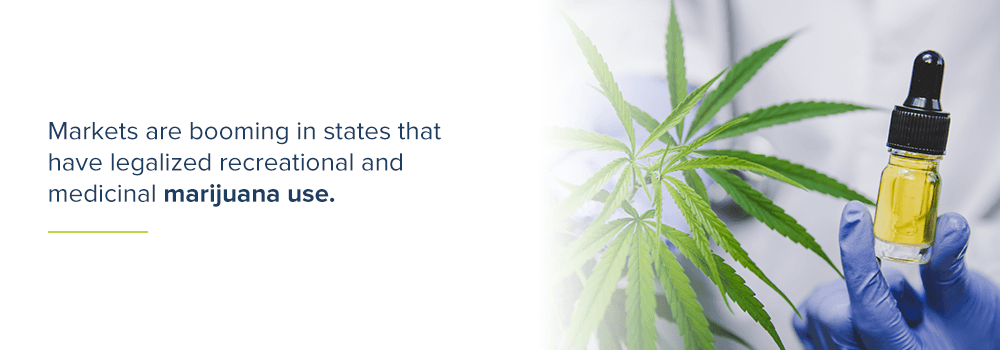
Companies using hemp in their products are now legally able to grow it themselves, thanks to the Hemp Farm Bill. The FDA has approved a drug containing cannabidiol (CBD). With all this forward movement, more and more companies are looking to partake. The FDA has stipulated, though, that CBD cannot be included in supplements.
Markets are booming in states that have legalized recreational and medicinal marijuana use. To do business in these states, companies should keep in mind the various regulations of the market. While marijuana may be included in food products in certain states, other states regulate how much can be included and how that information should be relayed on the packaging.
5. Sports Nutrition
Sports nutrition isn’t just for fitness enthusiasts. This industry also serves consumers of all ages and fitness levels. For manufacturers, this means the market is vast and targeting a niche group is even easier and more profitable than before.
For manufacturers of nutraceuticals, seniors can be a great market. Seniors deal with health problems that stem from inactivity and loss of muscle mass, so they can benefit significantly from nutraceuticals. Manufacturers may also want to consider producing nutraceuticals for athletes, for whom nutrition and wellness are of the utmost importance.
Uses and Applications of Nutraceuticals for People

What are nutraceuticals used for?
Nutraceuticals have many uses and applications for people. The guided use of nutraceuticals is known as nutraceutical imbalance therapy.
Many consumers buy their nutraceuticals at local health food stores or over the counter. They may purchase one of these products with little understanding of what the nutraceutical does, and this can mean the consumer doesn’t get the results they want. Maybe they have purchased the wrong product or use an incorrect dosage. Unfortunately, this can mean consumers stop using nutraceuticals altogether because they don’t believe the products provide any positive effects.
Nutraceuticals supplied by medical professionals tend to be higher-quality products that have been tested thoroughly and will have better results than those that can be accessed over the counter on your own.
Doctors most often recommend using nutraceuticals to correct imbalances within the body. By correcting imbalances, patients can improve their health and wellbeing.
1. Forms of Nutraceutical Therapy
Nutraceutical imbalance therapy includes a few well-known forms. Below are examples of nutraceutical applications:
- Glutathione liver cleanses: This therapy helps to cleanse your liver.
- Gender-specific multivitamin therapy: These treatments are specific to your gender and are created with the goal of balancing and promoting healthy hormone production.
- Methionine Inositol Choline (MIC): This therapy involves administering injections to reduce body fat.
- Amino acid injections: This therapy also helps reduce body fat.
While it can seem that many nutraceuticals are for weight loss, nutraceuticals treat and prevent several health conditions.
2. Potential Side Effects of Nutraceutical Therapy

Are nutraceuticals safe to use? Fortunately for consumers, nutraceuticals are considered safe for the general population because they are extracted from natural, whole foods. Using nutraceutical therapies could result in some potential side effects, including:
- Allergic reaction
- Insomnia
- Excessive blood-thinning
- Cardiac arrhythmias
If a consumer is using a medication or another supplement, they could face the risk of the nutraceutical interacting poorly with their other medication.
Consumers can avoid these potential side effects and risks by simply talking with their physician and letting them know all the medications, supplements and nutraceuticals they are taking. When doctors have all the necessary information they need for a patient, they can provide more effective care and avoid treating patients with supplements that could cause unpleasant interactions with a nutraceutical.
3. Conditions Treated by Nutraceutical Therapy
Most people can benefit from using nutraceuticals. For people with certain conditions, nutraceuticals can provide substantial health improvements. These conditions include:
- Anxiety
- Chronic fatigue
- Depression
- Genetic dispositions to chronic disease
- Hormonal support due to aging or menopause
- Insomnia
- Low energy
- Obesity
- Poor cognition or brain fog
More serious illnesses and conditions can also be treated or aided with nutraceutical therapy. Consumers should consult their doctor first if they have a more serious condition, as they are likely also taking other medications to treat the illness. A doctor’s input can help prevent negative interactions or interference with prescribed medication.
Uses and Applications of Nutraceuticals for Pets
People aren’t the only ones who can benefit from the use of nutraceuticals. There are also nutraceuticals for dogs, cats and other animal species. Nutraceuticals such as glucosamine can help treat arthritic conditions, and antioxidant compounds can also help prevent cancer.

Consumers can prevent their pets from acquiring diseases or treat existing diseases with nutraceuticals. Nutraceutical use can reduce and may even eliminate the need for traditional medications. This can be a much more affordable alternative for pet owners. Pets also won’t have to suffer through adverse side effects that come from conventional medications.
Many of the chemical actions in nutraceuticals are unique to the product and can’t be found in pharmaceuticals. Silymarin in Milk Thistle prevents damage to liver cells. Quercetin, which can be found in several plants, stabilizes mast cells in the immune system to prevent allergic reactions.
Some nutraceuticals have been used with pets for decades, while others are newer and still being introduced into veterinary medicine. Most veterinary nutraceuticals are for cats, dogs and horses, but the use of nutraceuticals is also being explored for other animal species, such as marine mammals, birds and reptiles.
Nutraceuticals can present a variety of benefits for pets. These positive effects include:
- Control of infection by viruses, bacteria and parasites
- Elimination of infection by viruses, bacteria and parasites
- Immune regulation
- Improvement of metabolic processes
- Support of organ structure and function
- Support of blood supply to organs
Most pets respond well to the use of nutraceutical therapy. Most nutraceuticals are also safer than traditional medications, which means pet owners can feel more peace of mind when it comes to their pet’s health.
Prescriptions are typically not needed for most nutraceuticals for pets, though a veterinarian may suggest their preferred brands or sources to their clients.
One of the major uses of nutraceuticals for pets is in the management of arthritis. Arthritis can affect mobility in dogs and cats and cause discomfort. Nutraceuticals help improve mobility in cats and dogs and relieve them of discomfort.
Arthritis is an irreversible condition caused by degenerative and inflammatory changes in the joints. With nutraceuticals, the progression of arthritis can be slowed and discomfort caused by the condition can be greatly reduced.
Typically, moderate to severe arthritis pain is treated with prescription medicines. These medications can have a range of adverse side effects, however, such as gastrointestinal upset, blood clot formation in the lungs and perforation of the stomach wall. These side effects can be dangerous and even life-threatening.
Nutraceuticals can provide relief without the dangerous side effects.
Nutraceuticals come in oral and injectable forms for cats and dogs. They can be used to complement prescription drugs or as an alternative to drugs prescribed by a veterinarian. They’re also quite affordable and effective, and side effects are extremely rare and mild. If a pet has a mild case of arthritis, a nutraceutical alone may be enough to control the pet’s symptoms. For advanced cases, nutraceuticals can lower the dosage needed for a prescription drug.

Nutraceuticals reduce pain for pets, and they can influence the architecture of joints over time. The padded cartilage that covers the surfaces of bones and is involved in the articulation of joints can be strengthened and possibly even repaired by nutraceuticals. They can also be used for the nourishment of synovial fluid in the joints, which makes movement of the joints more uniform and less painful.
Regular use of nutraceuticals can maintain anatomical changes and improve joint health, along with the pet’s quality of life.
Pet owners should use nutraceuticals that are specifically made and packaged to be used by cats and dogs. By selecting products that are specific to the species, pet owners can find the right products easily and use safe doses. Before a pet owner begins administering nutraceuticals to their pet, they should consult with a holistic veterinarian.
For arthritis relief, there are many nutraceuticals available for pets:
1. Chondroitin Sulfate
This complex sugar is found in joint tissue. Certain proteins and molecules bind with chondroitin to form cushiony tissue in the joints that absorbs shock. Joints that have a chondroitin deficiency are at risk of developing degenerative joint disease.
2. Glucosamine HCl
This is a type of sugar that can be found in various tissues of the body, including bones. Glucosamine HCl helps prevent inflammatory substances from forming in the joints. It can also help maintain the health of cartilage cells and encourage the production of important proteins, which maintains the health of joints.

3. Green-Lipped Mussel Extracts
Also known as Perna canaliculus, these extracts are formed from shellfish and include anti-inflammatory properties. The compounds found in the mussel prevent inflammation by inhibiting the substances that signal an inflammatory response within the body.
Supplements that contain Perna extract have also shown a reduction in pain for dogs that have osteoarthritis.
4. Herbs
Several herbs can be given to animals with arthritis to help with pain management. Some of these herbs include:
- Arnica
- Bittersweet nightshade
- Boswellia
- Lobelia
- Rhus toxicodendron
- Sanguinaria canadensis
- Symphytum officinale
- White willow
5. Hyaluronic Acid
This complex sugar is essential for the body’s ability to form healthy cartilage. Hyaluronic acid scavenges free radicals in the joints, giving the joint fluid improved viscosity and relieving joint pain.

6. Isoflavones, Isoflavonoids and Avocado Soybean Unsaponifiables
This group of concentrated, natural, bioactive compounds can manage degenerative joint disease in both animals and people. These compounds may be able to reduce the pain caused by joint inflammation and can support the formation of healthy cartilage.
7. Manganese
This trace mineral plays a role in antioxidant pathways that maintain the health of the cells in the body. Some cats and dogs may benefit from regulated, daily doses of manganese. To prevent over-supplementing, pet owners can use products that have a pre-measured quantity in every serving.
8. Methylsulfonylmethane
Also abbreviated to MSM, this compound contains sulfur and offers anti-inflammatory properties. But MSM does more than reduce inflammation. This compound is also used to maintain supple, healthy cartilage.
9. Modified Milk Protein
This protein is extracted from the milk of cows that are heavily immunized. The protein has been found to inhibit substances that cause inflammation within joints. When dogs and cats regularly consume this protein in combination with other supplements for joint health, they enjoy significant relief from arthritis pain.
10. Olive Oil
Vitamin E can be found in olive oil, along with other essential nutrients and antioxidants. Adding olive oil to the diet of an animal with arthritis can be quite helpful. If used for arthritis, olive oil should be used as a complement to Omega-3 fish oils, not as a replacement.
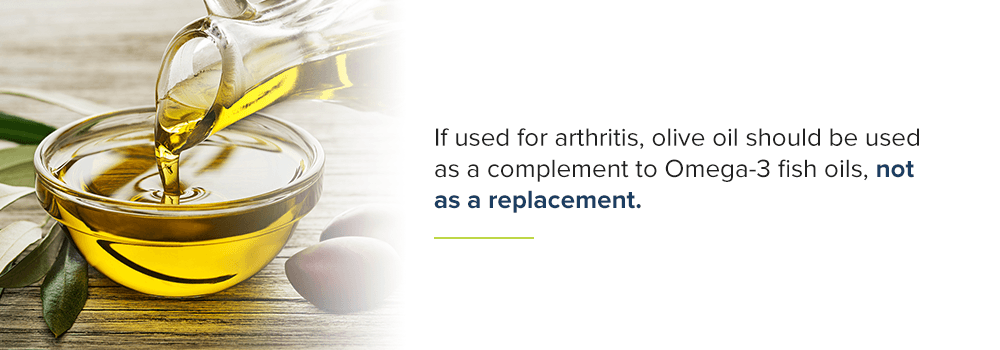
11. Omega-3 Fatty Acid
This nutraceutical comes from fish oil and can improve cardiovascular health. For pets with osteoarthritis and allergic skin disorders, Omega-3 fatty acids are often used as anti-inflammatory agents.
Omega-3, Omega-6 and Omega-9 fatty acids can be found in abundance in flaxseed oil. While this oil does provide anti-inflammatory support, concentrated Omega-3 fish oil still tends to be the better substance for managing osteoarthritis.
12. Tart Cherry Extract
This extract has been used by arthritis sufferers for decades to help alleviate chronic pain. This extract contains anti-inflammatory compounds that can reduce discomfort and joint swelling. Tart cherry extract can be found dried or in the form of juice or fruit flesh. Pet owners may be able to find this extract in health products for pet joints.
13. Vitamins B and C
These vitamins are vital, water-soluble compounds that should be given to older animals with arthritis. Pet owners can provide their pets with a well-rounded diet and a quality blend of vitamins, antioxidants and minerals to reach the recommended daily value of Vitamin C and Vitamin B.
14. Yucca
This plant offers anti-inflammatory properties. Soft, freshly-boiled yucca root can make a great treat for older, arthritic dogs. Pet owners can also find dried yucca stalk extracts in health food stores.
Nutraceuticals are a great way for pet owners to manage a pet’s arthritis. Daily nutraceuticals can increase a pet’s mobility and alleviate its discomfort.
Trust Acme-Hardesty for Your Nutraceutical Ingredients
Opportunity abounds for manufacturers in the nutraceutical industry. The market is there –– now consumers just need the best product that nutraceutical manufacturers can offer.
Over the last 70 years, Acme-Hardesty has evolved into one of the largest distributors of bio-based products from plant sources. We connect our suppliers with customers in North America, and we work passionately every day to bring our customers the high-quality service they deserve.
Contact us today to learn more about the products we offer at Acme-Hardesty.

